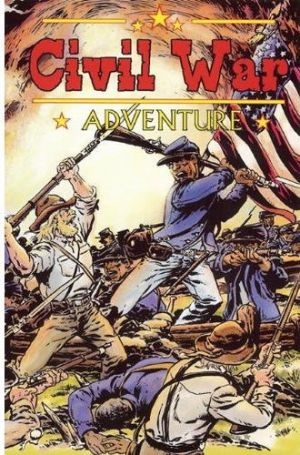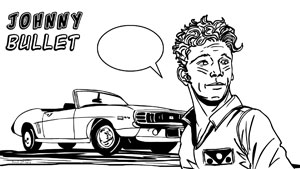|
|
 |
While divided into short prose and sequential art chapters, Civil War Adventures Vol. 2.1 opens with a map of the United States and Confederate States as they existed in 1860 and a Civil War timeline that highlights events from Nov. 6 1860 to April 14th, 1865. These two introductory tools allow the reader to refer back to the major events of the temporal settings of the short tales that follow. The map also gives the reader a ready reference as to the relative locations of the short tales’ events. The tales that comprise the volume include: “The March to Romney Part One,” “The Gray Ghost,” “Will the Black Man Fight? Part one” and “Johnny Java.”
“The March to Romney Part One” and “The Gray Ghost” both relate well the common soldiers’ life of marching, resting, and fighting. “The March to Romney Part One” tells the story of a group of soldiers from different cultural backgrounds that are thrown together and therefore exposed to different and new ideas about themselves and their compatriots. “The Gray Ghost,” which stars two of the time period’s larger and more recognizable figures, Lt. Col. John Singleton Mosby and Brig. Gen. George Armstrong Custer, illustrates the role that superstition, espionage, and infiltration played in the overall war.
The volume’s strongest tale, “Will the Black Man Fight? Part One” takes a look at the black soldiers of the 7th Louisiana Division and the questions on both sides of the conflict as to whether this group of hastily trained and inexperienced former slaves and field hands will be able to hold their own in battle when the time comes. The tale examines the positions taken by the commanding officers and some of the African-American soldiers themselves. The short tale is no Glory (1989), and doesn’t even answer the question on the minds of the military commanders (it ends just before the battle takes place), but it does a good job of introducing the topic of African-American soldiers and their experiences during The Civil War. It’s the most interesting tale in the volume and is the one that readers will most likely look forward to reading the conclusion to in the next volume.
The art in Civil War Adventures Vol. 2.1 is solid throughout. Kwapisz and Villagran do a great job of capturing the landscapes, dress, and weaponry of the time period. The volume is entirely in black and white (except for the front and back cover artwork), but this doesn’t detract from the visual appeal of the work overall. As these little history lessons begin to sell and the fledgling History Graphics Press becomes more profitable, perhaps some color volumes will ensue. This would only help to enhance the already great artwork and quality of these volumes.
 Cover to an earlier volume. |
As a history lesson, Civil War Adventure Vol. 2.1 would make an excellent ancillary addition to a textbook based Civil War history lesson. Very often history books, even if well illustrated with photos, can have a hard time capturing the imagination of young students. The promise of a fun history read in the form of a comic book can really serve as the spoonful of sugar that will help the medicine of a textbook lesson go down.
for more information visit: historygraphicspress.com
© Copyright 2002-2019 by Toon Doctor Inc. - All rights Reserved. All other texts, images, characters and trademarks are copyright their respective owners. Use of material in this document (including reproduction, modification, distribution, electronic transmission or republication) without prior written permission is strictly prohibited.

